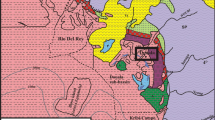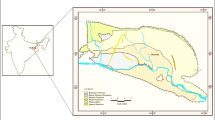Abstract
The contents of seven major components (TiO2, Fe2O3, MgO, CaO, Na2O, K2O and P2O5) and 15 trace elements (Sc, V, Cr, Ni, Cu, Sr, Y, Zr, Ba, La, Ce, Nd, Eu, Yb and Th) were determined by ICP-AE spectrometry in 27 samples of manganese nodules, micronodules as well as abyssal clay collected by dredging from an area of nearly 1,9802 nautical miles in the central Clarion-Clipperton abyssal plain at a depth of about 4,500 m. Statistical analyses were used to compare among individual as well as pooled datasets, in addition to different indicators such as La/Th, Ni/Cu and LREE/HREE ratios for the Clarion-Clipperton samples, as well as between these and corresponding values for the upper continental crust (UCC), North America Shale Composite (NASC), and igneous Indian and Pacific Mid-Ocean Ridge Basalts (MORBs). The results show significant correlations between major components in the Clarion-Clipperton samples and Pacific Ocean MORB, whereas trace elements (excepting Ni and Cu) correlate better with the UCC and NASC. There is also depletion in LREEs, together with a Ce negative anomaly for all Clarion-Clipperton samples. The nodule, micronodule and abyssal clay datasets each reveal typical clusters of components such as P2O5 and Y, La, Nd, Eu, Tb, or Ni and Cu. Compared to abyssal clay, the nodule as well as micronodules show significant enrichment in Ni and Cu; nevertheless, an essentially constant Ni/Cu ratio indicates that all samples come from the sediment surface. The distributions of major components as well as trace elements for the Clarion-Clipperton samples present, to different degrees, characteristics common to both the upper continental crust and Mid-Ocean Ridge Basalt, strongly implying a hydrothermal origin, most probably from East Pacific Rise material transported by the Pacific North Equatorial Current.
Similar content being viewed by others
References
Addy SK (1978) Distribution of Fe, Mn, Cu, Ni and Co in coexisting manganese nodules and micronodules. Mar Geol 28:M9–17
Addy SK (1979) Rare earth elements pattern in manganese nodules and micronodules from South West Atlantic. Geochim Cosmochim Acta 43:1105–1115
Bollhöfer A, Eisenhauer A, Frank N, Pech D, Mangini A (1996) Thorium and uranium isotopes in a manganese nodule from the Peru Basin determined by alpha spectrometry and thermal ionization mass spectrometry (TIMS): are manganese supply and growth related to climate? Geol Rundsch 85:577–585
Cronan DS (1977) Deep-sea nodules, distribution and geochemistry. In: Glasby GP (ed) Marine manganese deposits. Elsevier Oceanographic Series vol 15. Amsterdam, Elsevier, pp 11–46
Davis JC (2002) Statistics and data analysis in geology. Wiley, New York
De Carlo EH (1991) Paleoceanographic implications of rare earth element variability within a Fe-Mn crust from the Central Pacific Ocean. Mar Geol 98:449–467
Dekov VM, Marching V, Rajta I, Uzony I (2003) Fe-Mn micronodules born in metalliferous sediments of two spreading centers, the East Pacific Rise and Mid-Atlantic Ridge. Mar Geol 199:101–121
Dubinin AV, Saval’nov VN (2000) Geochemistry of rare earth elements in micro and macronodules from the Pacific bioproductive zone. Lithol Miner Resources 35:19–31 (translated from Litologiya i Poleznye Iskopaemye no 1, pp 25–39)
Dubinin AV, Saval’nov VN (2003) Geochemistry of the manganese ore process in the ocean: evidence from rare earth elements. Lithol Miner Resources 38:19–31 (translated from Litologiya i Poleznye Iskopaemye no 2, pp 115–125)
Dubinin AV, Volkov II (1986) Rare earth elements in metalliferous sediments of the Eastern Pacific Rise (in Russian). Geokhimiya 5:645–662
Glasby GP, Ren X, Shi X, Pulyaeva IA (2007) Co-rich Mn crusts from the Magellan Seamount cluster: the long journey through time. Geo-Mar Lett 27:315–323 doi:10.1007/s00367-007-0055-5
Goldberg ED (1963) Rare earth elements in the marine environment. J Geophys Res 68:4209–4217
Gromet LP, Haskin LA, Korotev RL, Dymek RF (1984) The “North American shale composite”: its compilation, major and trace element characteristics. Geochim Cosmochim Acta 48:2469–2482
Han X, Jin X, Yang S, Fietzke J, Eisenhauer A (2003) Rhythmic growth of Pacific ferromanganese nodules and their Milankovitch climatic origin. Earth Planet Sci Lett 211:143–157
Hein JR, Schwab WC, Davis AS (1988) Cobalt- and platinum-rich ferromanganese crusts and associated substrate rocks from the Marshall Islands. Mar Geol 78:255–283
Horn DR, Delach MN, Horn BM (1973) Metal content of the ferromanganese deposits of the oceans. Tech Rep Off Int Decade Ocean Explor 1:1–78
Jeong KS, Kanf JK, Lee KY, Jung HS, Chi SB, Ahn SJ (1996) Formation and distribution of manganese nodule deposits in the northwest margin of Clarion-Clipperton fracture zones, Northeast Equatorial Pacific. Geo-Mar Lett 16:123–131 doi:10.1007/BF02202607
Klein E, Langmuir C (2001) GERM MORB data by ocean basin, depth, and MORB type. http://earthref.sdsc.edu/GERM/data/klein/MORB_ocean.htm
Lalou C, Brichet E (1972) The signification of radiochemical measurements in evaluating the growth ratio of manganese nodules. C R Acad Sci Paris 275 D:815–818
Murphy K, Dymond J (1984) Rare earth element fluxes and geochemical budget in the Eastern Equatorial Pacific. Nature 307:444–447
Murray J, Renard AF (1891) Deep sea deposits. Report Scientific Results Voyage H.M.S. Challenger. Neil, London. http://www.19thcenturyscience.org/HMSC/HMSC-Reports/1891-DeepSeaDeposits/htm/doc.html
Piper DZ (1974) Rare earth elements in ferromanganese nodules and other marine phases. Geochim Cosmochim Acta 38:1007–1022
Raab WJ, Meylan MA (1977) Morphology. In: Glasby GP (ed) Marine manganese deposits. Elsevier Oceanographic Series vol 15. Amsterdam, Elsevier, pp 109–146
Roelandts I (1990) Inductively coupled plasma determination of nine rare-earth elements in sixty international geochemical reference samples. Geostand Newslett 14:137–147
Stoffers II, Dubinin AV (1987) Rare earth elements in hydrothermal accumulations of iron and manganese in the ocean (in Russian). Litologiya Poleznye Iskopaemye 6:40–56
Stoffers P, Glasby GP, Thijssen T, Shrivatsava PC, Melguen M (1981) The geochemistry of coexisting manganese nodules, micronodules, sediments and pore water from five areas in equatorial and S.W. Pacific. Chem Erde 40:273–293
Stoffers P, Sioulas A, Glasby GP, Schmitz W, Mangini A (1984) Sediments and micronodules in the Northern and Central Peru Basin. Geol Rundsch 73:1055–1080
Szobotca SA (1998) Petrological and geochemical study of abyssal sediments from the Central Pacific Ocean with special emphasis to manganese nodules (in Romanian). PhD Dissertation, University of Bucharest, Bucharest
Taylor SR, McLennan SM (1985) The continental crust, its composition, evolution. Blackwell, Oxford
Taylor SR, McLennan SM (1988) The significance of the rare earth in geochemistry and cosmochemistry. In: Gschneidner KA, Eyring L (eds) Handbook of Physics and Chemistry of Rare Earths, vol 11. Amsterdam, Elsevier, pp 485–578
Toth JR (1980) Deposition of submarine crusts rich in manganese and iron. Geol Soc Am Bull 91:44–54
Author information
Authors and Affiliations
Corresponding author
Rights and permissions
About this article
Cite this article
Duliu, O.G., Alexe, V., Moutte, J. et al. Major and trace element distributions in manganese nodules and micronodules as well as abyssal clay from the Clarion-Clipperton abyssal plain, Northeast Pacific. Geo-Mar Lett 29, 71–83 (2009). https://doi.org/10.1007/s00367-008-0123-5
Received:
Accepted:
Published:
Issue Date:
DOI: https://doi.org/10.1007/s00367-008-0123-5




